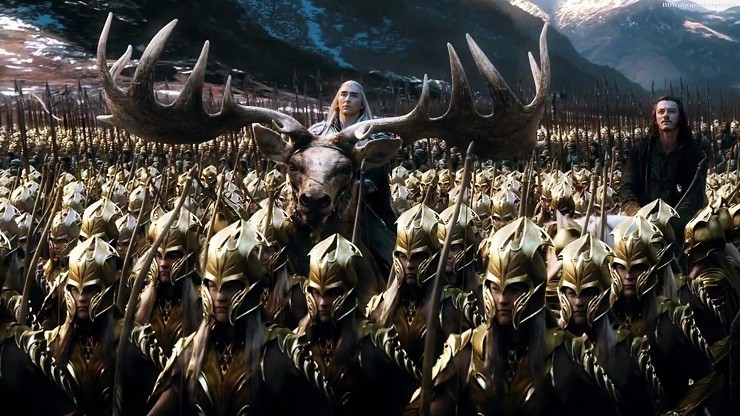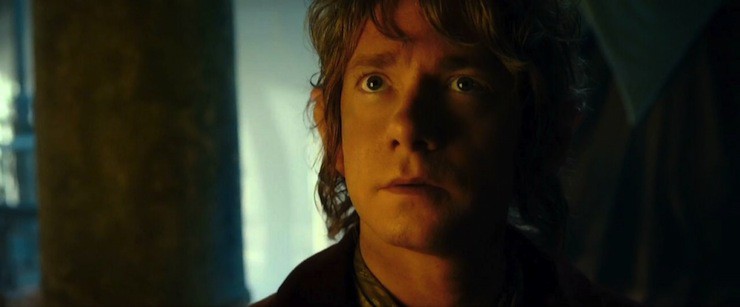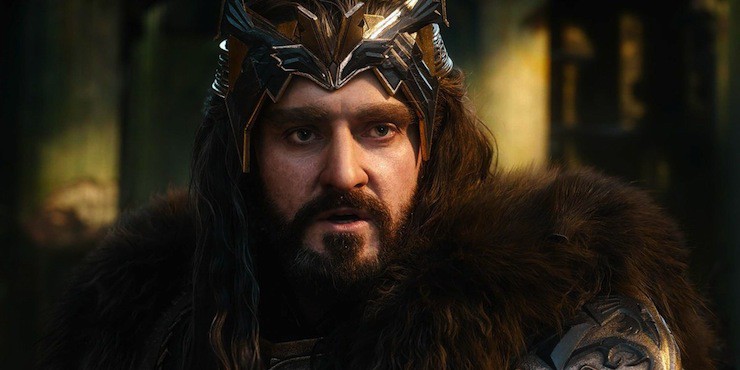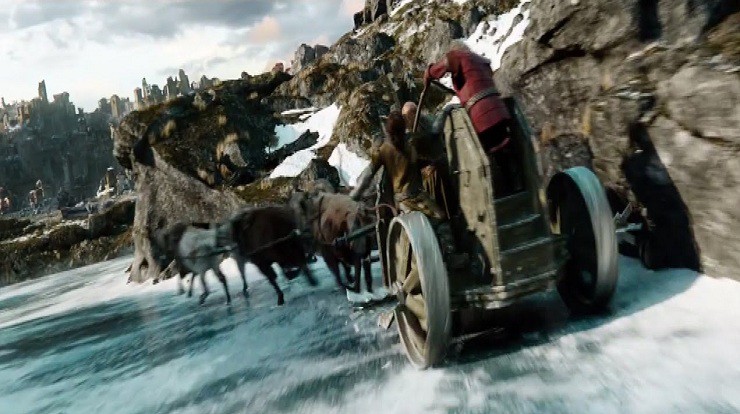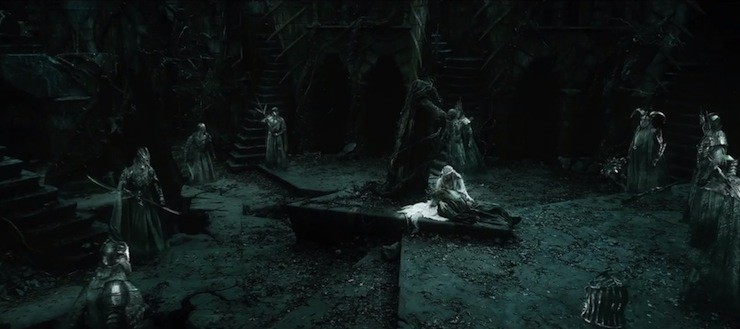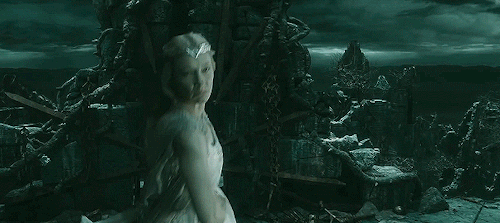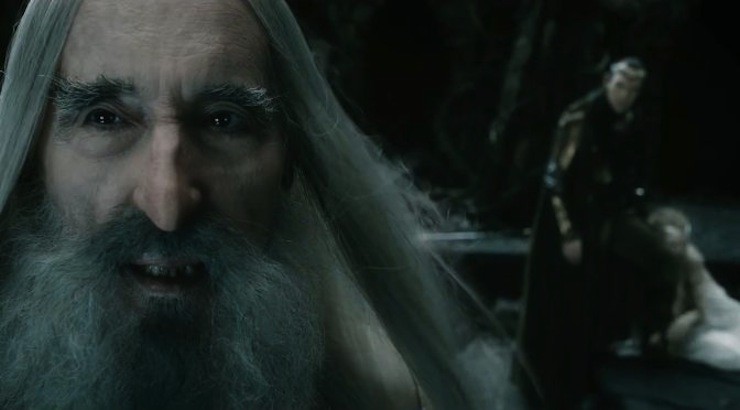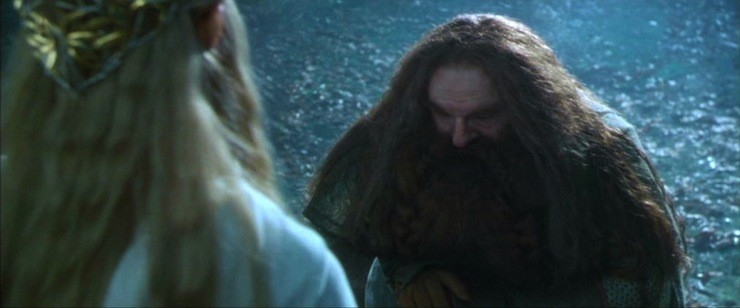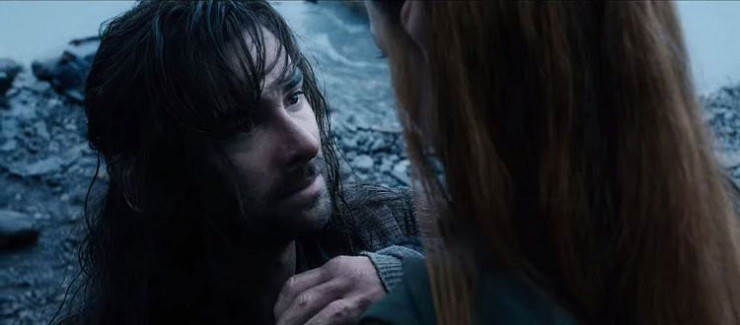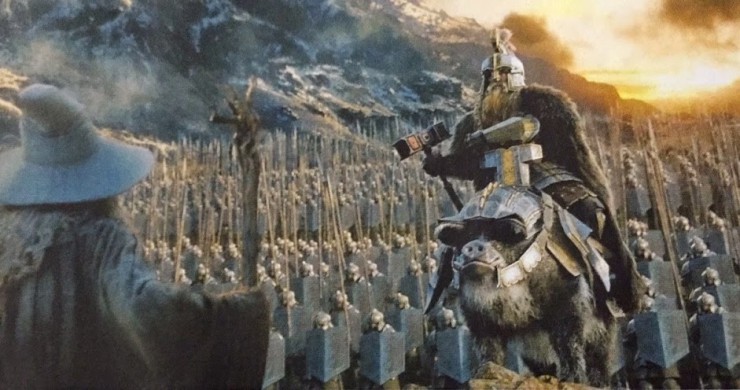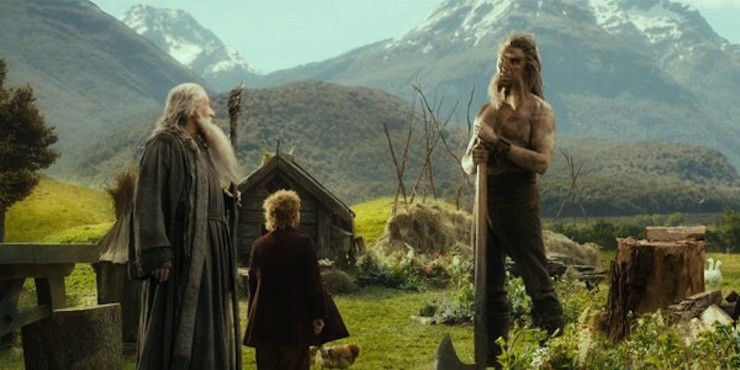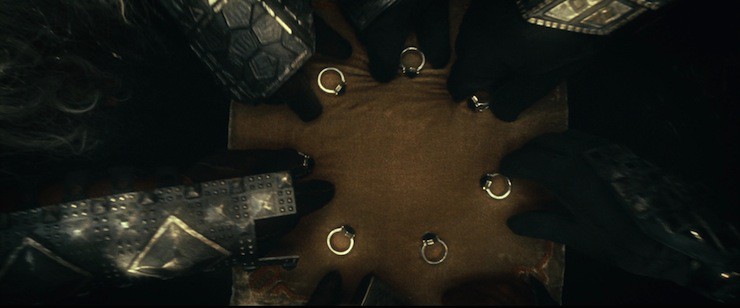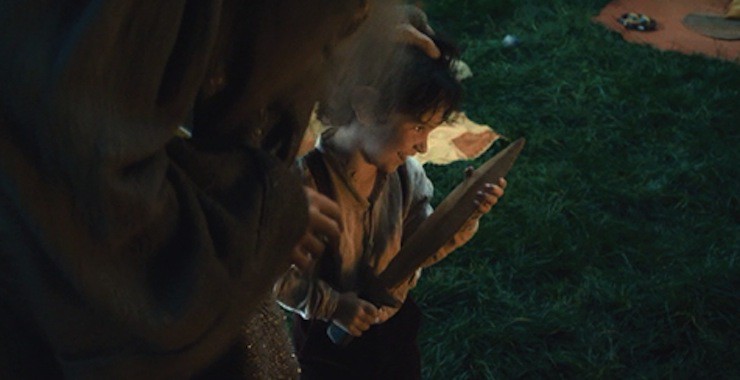This is an update of a previous post about Peter Jackson’s Hobbit films.
Yesterday, the Extended Edition of The Hobbit: The Battle of the Five Armies played in theaters as a prelude to its release on DVD/Blu-ray. And so with battle cries, the clash of weapons, and then a somber dirge, we have seen the trilogy-that-wasn’t-really-a-trilogy conclude. To be honest, I found it to be a curious admixture of satisfying and unfulfilling; the former because as a film saga, there is both excitement and sufficient closure, and the latter because it would have felt more complete, more “extended,” if Peter Jackson had deigned to drop in a few more looked-for elements from the books. But hey, war goats!
Spoilers follow for The Hobbit films.
Peter Jackson’s Hobbit films get a lot of flak for being overwrought, overlong, or “like butter scraped over too much bread.” Many of the criticisms are valid enough (I have some of my own), some are a matter of taste, and some, I feel, are simply misguided. My view, as a fan of Tolkien first and Jackson second, is that the naysayers are judging the films for what they’re not. They are not a cinematic translation of J.R.R. Tolkien’s singular novel but an adaptation in the truest sense of the word. Specifically, they are an adaptation of events in Middle-earth 60 years prior to the Bilbo’s famous eleventy-first birthday party, and that includes those from the The Hobbit and those implied from the Appendices of The Lord of the Rings.
To adapt something is to change, alter, or modify it to make it suitable for new conditions, which is where the problems occur for fans of a richly detailed story. No, not merely a story, a whole legendarium (Tolkien himself called it such) that lots of people care a hell of a lot about. The expectation seems to have been that Jackson should have kept to the books closely, should have told the story just as Tolkien did. But ultimately, that’s just not realistic and it would have made for a disjointed prequel.
It’s not like Jackson didn’t know what’s in the books; in addition to knowing them well, he was surrounded by Tolkien scholars, Elvish linguists, and other literary experts. Rather, he’s an uber-successful director, producer, and screenwriter who has to wrangle massive movie budgets and we’re not. He loves Tolkien’s work but had taken on the self-imposed, if herculean task of maneuvering a beloved tale through the Hollywood machine. Have you ever watched a comic book, novel, or even play adapted to film and thought, “That’s exactly how I would have done it”? If you have, then that’s amazing! If not, well, in this age of Hollywood remakes, reboots, and adaptations, why expect these films to be any different?
I want a faithful adaptation as much as anyone. But I am not a Tolkien purist about it because I think that Peter Jackson adding Tom Bombadil to The Fellowship of the Ring would have been as absurd as, oh, say, adding a scene in The Hobbit where Thorin & Co. enter the Lonely Mountain right after sending Bilbo in—you know, to go in quietly and do what they had specifically employed him to do. “That, Master Burglar, is why you are here,” Thorin says to him. So yes, that scene was too much. Do I love seeing what various chambers in Erebor might look like? The forges, the billows, the vats, the cavernous abyss of a great mine shaft? The fantasy nut in me says hell yes! But the Tolkien reader in me says no, not for a gratuitous and overlong action sequence, and not at the cost of undermining Bilbo’s quiet resolve.
Certainly not at the cost of losing this wonderful moment from the book:
It was at this point that Bilbo stopped. Going on from there was the bravest thing he ever did. The tremendous things that happened afterwards were as nothing compared to it. He fought the real battle in the tunnel alone, before he ever saw the vast danger that lay in wait.
Of course, it’s hard for any film to portray a character’s internal thoughts, which is all that moment is, but I think most of us would agree that Martin Freeman would have done an excellent job visually depicting Bilbo’s trepidation. Peter Jackson opted not to try this, and we can and must live with that. The book is not demeaned, but the movie is the lesser for it.
Likewise, Peter Jackson opted to keep Bombadil out of The Fellowship of the Ring, which it must be remembered had been his first foray into Middle-earth. And which, honestly, we’re still lucky even happened. And I agree with nixing Tom not because I wouldn’t like to see him or his oft-referenced yellow boots on the big screen—because that would be both fun and surreal—but because I don’t think anyone but die-hard book fans would have had the patience for him, his lovely but passive wife Goldberry, or his flamboyant, “Ring a dong dillo” self. Simply look at the numerous complaints of “too many endings” levied against The Return of the King. Jackson’s Fellowship would have faltered with the excess of Tom Bombadil (and even the barrow-wights, which I’d dearly love to have seen) and then millions of people would never have come to know or appreciate the greater works of Professor Tolkien. And the Tolkien Estate’s book revenue wouldn’t have increased by 1,000% (in the UK) as they did despite its utter contempt for Jackson’s meddling.
I reread all the books after seeing the films and I enjoying every unabridged word. Likewise, I’m happy to watch Peter Jackson’s six adaptations as a hybrid member of the audience, fully accepting that no one demographic can be fully satisfied. Among the many, you’ve got:
- Hardcore Tolkien fans who gripe at every change from the books (but still go see the films).
- New fans who loved the films and have now discovered the books.
- Action-adventure moviegoers who just want to be entertained but probably won’t ever read the books but “OMG look how badass that elf is with all the arrows and the shield-skating acrobatics and crumbling-tower-climbing and monster-bat-riding!”
- Kids, especially young girls who, according to the director himself, might be glad to have a relatively strong female character to root for (in Tauriel and Galadriel), where otherwise The Hobbit would have had none.
The point is that untold numbers of people have enjoyed all three Hobbit films, sometimes because of—and sometimes despite—their Jackson-expanded elements. Now that the Extended Edition of The Battle of the Five Armies is upon us, I’d like to consider the bigger picture.
I found The Battle of the Five Armies to be extremely fun. And a fine conclusion. And by that I mean that it’s a fitting capstone to the prequels for Jackson’s Rings trilogy. I never had qualms about The Hobbit being split into three films on principle. From the coming of Thorin to Bilbo’s home (July of the year 2941) to the return of Bilbo to Bag End (June of 2942), about 11 months pass. That story is told with three films. Meanwhile, from Frodo’s departure with the One Ring from Bag End (September 23, 3018) to all four hobbits returning to the Shire after Sauron’s defeat (November of 3019), about 14 months elapse. Again, three films. The span of diegetic time is comparable. Granted, there are more moving parts and political conflicts during the War of the Ring, but just as in the Rings trilogy, there is plenty happening behind the scenes during the quest for Erebor that Tolkien addressed long after writing it. The White Council moving against Sauron in Dol Guldur is one prime example.
It’s been said that “the filmmakers have wrung all they could out of the source material,” but I find that to be a lazy stab because it’s simply untrue. Indeed, that’s the irony. While three Hobbit films meant there should be room for some fleshing out of otherwise sparse details—the very thing people are complaining about, that he made a short book longer than they felt it needed to be—Jackson still didn’t actually cover everything. What he did do was garnish the films with more action and adventure. The Extended Five Armies is rife with monstrous combatants and innovative new war machines—trolls clad with gruesome-if-amusing armaments, dwarven ballistae that can and do shatter a hail of elven arrows, and bolt-firing war carts to name a few. It’s a true spectacle. Where Tolkien nerds might roll their eyes and wish for the story to get on with things, there is an audience for this and it does please.
And here’s an interesting development from the Extended Five Armies that really struck me: Before the orcs arrive, the Elves and dwarves do actually begin their battle at Dáin Ironfoot’s command. There is a clear loss of life on both sides, even though it’s brief. It’s heartbreaking to watch, a tragic consequence of the tension built up to that moment. You would think Azog, spying this elf-dwarf conflict from his command tower, would just let things play out! Regardless, the orcs arrive and with seemingly no hesitation—I love the unspoken certainty of this—the Elves and dwarves cease their fight with one another and engage the common foe. As if they had no heart to fight one another anyway. But both have an ancient hatred for orcs!
Battles and monsters are certainly Jackson’s forte, and the films cater to the movie-going crowd more than to the book-reading crowd. For those of us in the middle of that Venn diagram, it’s enough. At least in the new scenes, we are treated to seeing more of Thorin’s company engaged in the battle—including the unexpected removal of the axe blade in Bifur’s head! There is plenty of dwarf humor in the fray, but against the gravity of what’s going on, I found that to be quite welcome. Oh yeah, and Balin riding the war cart and peppering wargs with ballista bolts? Yes to that. This is part of a larger segment showing that the ride to Ravenhill to challenge Azog was considerably more difficult than we first assumed from the film’s initial release.
Some of the Extended moments weren’t quite enough to satisfy and they didn’t tie in well with previous ones. For example, we get only a few extra seconds of Beorn’s arrival at the battle and his ursine, orc-mashing fury, but nothing more. And though Gandalf has a few additional words for Thorin while the dwarf fumes at Erebor’s makeshift gate, I kept waiting for him to somehow mention Thrain, who he discovered in Dol Guldur in Desolation. If not in this scene, then in another. “Tell Thorin that I loved him,” Thrain had said to Gandalf. “Will you do that? Will you tell my son that I loved him?” Gandalf never does. It’s a small thing, but it would have made for better continuity to include.
I can abide almost any extension or stretching of characters and themes and battles, so long as they’re not completely antithetical to Tolkien’s ideals, but only if the existing story, including the appendices-based backstory, is exhausted first. There is much we never get to experience from the books. The animals at Beorn’s house; the Eagles and their eyries (and why they help at all); the drunk Wood-elves and Thranduil’s interrogation of the dwarves; the thrush and its world-saving delivery of vital information; the aftermath of the battle—all of these have been kept out. In the behind-the-scenes features of the DVDs, you can even see that some of these were filmed (such as all the captive dwarves being brought before the Wood-elf King, not merely Thorin), but never made even the Extended cut. Sadly.
But these are movies; they need to take into account a movie-goer’s patience (and bladder). Think of all that was removed from The Lord of the Rings, which has a full run-time of just over 11 hours. Given that, are you in the “What, no ‘Scouring of the Shire’?” camp or the “Nah, it’s fine as is” camp?
Still, in The Battle of the Five Armies, every second of screen time given to the character of Alfrid was one less that could have been better used developing the White Council’s purpose. Explaining who they are exactly, how their Rings of Power relate to one another, that sort of thing. We get only teasings of the world these immortal Elves and wizards come from: we glimpse Narya, Gandalf’s ring, and of course Galadriel’s. There is so much story in the rings that never comes out. Whereas Alfrid is an unnecessary, cartoonish weasel. In any case, it seems the Master of Lake-town’s fate in the book has become Alfrid’s fate in the film and the dragon-sickness gets to him. In the Extended cut, Alfrid does get his comeuppance. While I’d prefer he simply vanish to starve in the Waste with his stolen gold—but how do you show that in a film? (you can’t)—for some it may be satisfying to see Alfrid meet his mouthy end.
The White Council’s ousting of Sauron from Dol Guldur still feels the most truncated, even in the Extended Edition, if only because we know there’s plenty of lore behind it. It has a direct bearing on other events, which Gandalf touches on briefly later and it explains why he stirred Thorin to his quest and nosed around Dol Guldur in the first place.
Per Appendix B of The Lord of the Rings:
Among many cares he was troubled in mind by the perilous state of the North; because he knew then already that Sauron was plotting war, and intended, as soon as he felt strong enough, to attack Rivendell. But to resist any attempt from the East to regain the lands of Angmar and the northern passes in the mountains there were now only the Dwarves of the Iron Hills. And beyond them lay the desolation of the Dragon. The Dragon Sauron might use with terrible effect. How could the end of Smaug be achieved?
I enjoyed seeing the ringwraiths in their more spectral form, even if their inclusion via the High Fells of Rhudaur were an addition. This is a prime example of where I don’t mind Peter Jackson’s tinkering; it was never made clear by Tolkien where the Nazgûl would have been during this timeframe. No harm, no foul, why not see them again? That said, more spellcasting and less wizard-fu in the Dol Guldur skuffle would have been preferred, but it’s still gratifying to see Galadriel finally invoke some epic, Silmarillion-flavored might. She will one day return there, after all, when the Shadow is defeated.
Also from Appendix B:
Three times Lórien had been assailed from Dol Guldur, but besides the valour of the elven people of that land, the power that dwelt there was too great for any to overcome, unless Sauron had come there himself. Though grievous harm was done to the fair woods on the borders, the assaults were driven back; and when the Shadow passed, Celeborn came forth and led the host of Lórien over Anduin in many boats. They took Dol Guldur, and Galadriel threw down its walls and laid bare its pits, and the forest was cleansed.
But I do wish her bearing was brighter and less dark-queen creepy, which is clearly meant to gel with her Fellowship manifestation. In Five Armies, she is not being tempted by great power, she’s using her own. I think the visual connection was too much handholding. Likewise, I wish her voice was not once again layered and pitch-dropped—Jackson’s sound crew, having proved themselves throughout all six films, could have done way better than use that cheap trick.
Still, in the Extended cut, we now get to see her utterly obliterate Gandalf’s orc jailor—who seconds before was ready to cut the wizard’s ring from his finger after beating on him. Indeed, the orc was strangely informed: he knew of the Ring of Fire and demanded to know “Where are the others?” That is when Galadriel arrives and makes short work of the orc.
Saruman himself is underused throughout the trilogy, though it was a joy to see the much-aged (and now late) Christopher Lee return to the role. He is the head of the White Council, and though he kicks serious Nazgûl ass in Five Armies, he seemed more horrified than intrigued at the sight of the Enemy, who he was charged to oppose from the start. I was hoping for deeper insight into his own corruption and eventual betrayal. In the canon, he was already desiring the One Ring for himself at this time and had discovered only two years prior that Sauron’s servants were searching the Anduin near Gladden Fields. Which is why he’d finally agreed to move against the Dark Lord, to keep him from finding the One first.
“Leave Sauron to me,” seems to be the only hook we get. But anyone who’s read more about Saruman knows that he regarded Sauron as a rival, not merely an enemy, at this point in time.
As for Tauriel and Kili, this is all there is to it: In An Unexpected Journey and only in the Extended Edition, we see Kili eyeing an Elfmaid in Rivendell, so we know he’s prone to elven interests. Then in Desolation, he meets Tauriel and actually falls for her (as much as a dwarf can in so brief a time) and is subsequently saved by her efforts. Then in Five Armies, it all comes to a head and one dies trying to save the other.
I’ll say two things about this subplot then leave it alone, since much has already been said and because it’s a small matter compared to the rest of the story.
Tolkien’s Elves, while portrayed quite differently in the films than in the books (a topic for another time), are still presented as a tragic, if powerful race. To me, the tale of Kili and Tauriel is less about an Elf and dwarf romance as it is the adversity that lies between an immortal and a mortal. That is a theme that Tolkien cared much more about and he played with this idea several times, in Beren and Lúthien, in Aragorn and Arwen. Even Elrond and his brother Elros were given the choice of mortality or immortality; Elros chose the doom of a mortal Man (and surprise, chose a mortal wife), while Elrond chose immortality. The brothers were therefore parted by the passage of thousands of years.
There is also precedence for a rare fondness between Elves and dwarves despite their ancient and Silmarillion-documented feuds of the past. In the Rings trilogy, not only do Legolas and Gimli forge an everlasting friendship with far-reaching effects, but Gimli is powerfully smitten by the beauty of Galadriel and it changes him deeply. The dude won’t shut up about her sometimes, it’s awesome.
And it happened in a moment, at their first meeting. Like…Tauriel and Kili, though of course one is romantic and the other is not. Against all these, the cinematic contrivance of Tauriel and Kili’s brief but unexplored love is nothing to fret about. Yes, it’s annoying to see an Elf lose her head, teenager-style, in the midst of a great battle—and more so because she’s one of the few female characters—but she’s still the only Elf pushing to oppose the orcs because it’s the right thing to do. Even Legolas would not have without her urging, and daddy Thranduil merely covets gems. (Side note: In one podcast interview, Hobbit writer Philippa Boyens clarified that the white gems that Thranduil wanted to badly had been commissioned for his wife, before her death, and that is why he is so fixated on his claim. It’s all he’d have of her, since Legolas tells Tauriel that his mother’s body was never found. To immortals such as Elves, memory can be everything. Even Boyens wasn’t sure if Peter Jackson would add this detail into the Extended cut, and in the end, he did not.)
So you may feel the Elf-dwarf romance feels forced, and the alleged affection between Legolas and Tauriel is also hard to buy into—in part because the films have made Elves colder than their literary counterparts—but it’s also harmless. So a character with little personality in the book (Kili) is given feelings for a character nonexistent in said book (Tauriel). Big deal. It’s not like Jackson gave Bilbo a girlfriend. Thankfully.
Honestly, I’m just happy to see female Elves, period, especially in battle. In the massive ranks of armored and militant Elves—at Helm’s Deep or even in the Last Alliance prologue—are there any? I did manage to glimpse a few female warrior Elves among the masses in Five Armies, though. Good.
The fact is, the biggest portion of the trilogy are the adventures of the titular hobbit, and Martin Freeman’s Bilbo remains the highlight, diminished only in scenes where he’s upstaged by the actions of others. I was quite content with his role in Five Armies, since the “Thief in the Night” sequence was more or less faithful to the book and his involvement in the battle itself was extended only lightly. Bilbo’s parting words with Thorin as the dwarf lies mortally wounded were meaningful to me, if much too abridged—but then that’s generally my only complaint. The Extended cut, at least, does reveal the funeral for Thorin, Fili, and Kili, as well as the crowning of Dáin Ironfoot. Though it is brief, it brings more closure to the story.
If you watch the films and then read the corresponding events in the book, you’ll find that Tolkien’s storytelling method has a curious, tell-don’t-show chronology to it—something he did in The Lord of the Rings but perhaps not as arbitrarily as in The Hobbit. I’ve heard it complained that Fili and Kili’s deaths were “much better” in the book by naysayers of the film. To that I say, there was no scene at all in the book relating their deaths, merely a past perfect, after-the-fact summation of what happened. All we get is:
Of the twelve companions of Thorin, ten remained. Fili and Kili had fallen defending him with shield and body, for he was their mother’s elder brother.
So I for one am grateful for the things we do get to see brought to life on the big screen. The Rings trilogy was full of satisfying “off screen” moments from the books brought on screen, like the Ents’ assault on Isengard and Boromir defending the hobbits from orcs. Hell, to me Dáin Ironfoot’s portrayal in Five Armies was enjoyable even CGI’d as he was, and seeing an army of dwarves gratifies the D&D freak in me. Dáin, like Bolg, like Thranduil, like most of the dwarves, are given personalities Tolkien doesn’t take the time to do.
And that’s fine that he didn’t. It was a single book he wrote before launching the true enormity of Middle-earth. Tolkien was a revisionist, and even went back and made changes to The Hobbit once he started to write The Lord of the Rings. (In the first edition of The Hobbit, Gollum bets Bilbo his magic ring if the hobbit wins their riddle game—imagine that!) But Tolkien was content merely to bridge The Hobbit with Rings in other ways and not rewrite everything from the start.
2001’s The Fellowship of the Ring is a miraculous, groundbreaking film and each of Jackson’s installments since have, in spirit, style, and Tolkien lore, been like a carbon copy of the previous one, so that 2003’s The Return of the King was still excellent and felt close to Fellowship, but 2014’s The Battle of the Five Armies is certainly a far cry from it. Yes, it’s far more flash and action than rich storytelling and certainly bears even less resemblance to the source material, but it is at least consistent with its own vision of Middle-earth. And that’s what they all are: the vision of one man (Jackson) who stands at the vanguard of an army of talented artists and filmmakers. Because of that army, it’s still a hell of a lot of fun to experience. And Howard Shore’s score still somehow legitimitizes it, just like a John Williams score and a lightsaber sound effect can still, just for those choice moments, invoke nostalgia in even the crappiest Star Wars film.
The Hobbit trilogy is not perfect, of course not. There are numerous things to pick at. The stone giants sequence in An Unexpected Journey was needless showing off of CGI and presented a hazard to the characters only vaguely suggested in the book. The barrel-riding scene was turned into an action sequence that downplayed Bilbo’s day-saving role in their escape. But at least the stone giants and the barrels are in the book. Some of the added dialogue just doesn’t work. Fili telling his brother “I’ve got this!” at Ravenhill is gratingly anachronistic and not remotely Tolkien-esque. Though a pretty mild offense, I found Saruman referring to the Necromancer as a “human sorcerer” disappointing because the word “human” is never used by Tolkien to refer to Men in the books. Legolas and Tauriel reaching Gundabad and returning again in so short a time undermines the length of Bilbo’s entire journey. Jackson certainly played fast and loose with geography.
All the birds and beasts have been de-anthropomorphized. The Eagles did not speak, and neither does Roäc the raven nor the thrush. Beorn’s sheep, dogs, and pony friends don’t serve Thorin and Co. their meal as they do in the book. But these things wouldn’t exactly be in keeping with The Lord of the Rings, anyway—neither Tolkien’s nor Jackson’s.
When I first saw An Unexpected Journey, I loved it but I have learned to accept the things that didn’t play out more like in the book. Why, I fretted, didn’t they use the Great Goblin’s actual dialogue from the book? Sure, add some new lines but don’t replace what was there wholly. But I’ve learned to let it go. As J.R.R.’s own grandson has said, the films “kind of have to exist in their own right.”
Repeated viewings of all six films continue to impress me, and watching the making-of featurettes on the Extended Edition DVDs you can see some light shed on reasons for the changes even if they’re not what you’d have done. For me, I pine not for a perfectly faithful translation of the books but for the additions that could have been. The opportunities for greater context were there, right under Peter Jackson’s nose. We’ve met Radagast (who totally would have been given at least a cameo in Fellowship if Jackson has made the Hobbit films first), we’ve heard of the “two Blueses,” and we’ve seen the White Council in action. Why not use all that to show, even just a little, what Gandalf really is, why he’s constantly prodding everyone to oppose Sauron, and how he had the power to “rekindle hearts in a world that grows chill.”
Why not address the Nine, the Seven, and the Three? Especially the Seven, since the fate of Durin’s folk, their greed, and Sauron are all related? It was Sauron’s work that fanned the gold lust of the dwarves through the Seven Dwarf-rings. In the Extended Desolation, some time is spent showing how Thrain once had the last of the Seven but how it was cut from his hand by Azog. Why show the rings at all if we’re not going to learn something more of their power?
But alas, that would not have been done so easily, as a lot of that lore comes from The Silmarillion and the Tolkien Estate has not yielded that license. Not to mention the awesomeness of The Unfinished Tales, which reveals all kinds of good stuff about the Istari—and Saruman specifically.
The films are not the books and shouldn’t be judged as such. If they’re not what you hoped for, fair enough. You can’t please everyone, but don’t try and take them away from those they did please. As old John Ronald Reuel himself wrote in his Foreword to the Second Edition of The Lord of the Rings:
As a guide I had only my own feelings for what is appealing or moving, and for many the guide was inevitably often as fault. Some who have read the book, or at any rate have reviewed it, have found it boring, absurd, or contemptible; and I have no cause to complain, since I have similar opinions of their works, or of the kinds of writing that they evidently prefer.
Personally, I’m pleased with any franchise which shows, however briefly, Belladonna Took’s son as a small child, merrily play-battling with Gandalf the Grey, a symbolic and touching moment for all that would follow. Not only does it show that a mighty Maia spirit was fond of the simple Shire folk, it also shows why he would select one of them in particular to turn the tide.
Jeff LaSala can’t wait to read The Hobbit to his son, who is much too young to realize how nerdy his dad is. For now, they’ll just be pointy-eared denizens of Middle-earth together for Halloween.










